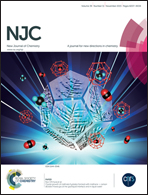Stability of conformationally locked free fructose: theoretical and computational insights†
Abstract
Despite many experimental and theoretical investigations, a quantitative explanation of the factors governing the stability of sugars is rather scarcely attempted in the literature. A quantitative understanding of such factors is important for correlating the stability of these molecules with their function. Recent experimental–theoretical studies report the global minimum structure of fructose and provide qualitative information about the predominant factors that determine the overall stability. In the present work, we quantitatively show that the relative stability of different conformers of fructose in the gas phase, albeit somewhat approximately, can be obtained in terms of the collective effect of (i) the sum of the energies of all the hydrogen bonds in a given conformer, (ii) the strain energy of a bare fructose ring, and (iii) the sum of anomeric stabilization (endo + exo) energies. The combined effect of these three factors is indeed useful for explaining the conformational landscape of fructose. The calculated relative stability of fructose is in good agreement with the one obtained from the relative energies of these sugar molecules. The large energetic gap between pyranose and furanose conformers is also well-explained. It is concluded that the small ring strain, the sufficiently large sum of the energies of the intramolecular hydrogen bonds and the higher stabilization due to anomeric interactions in β-fructo-pyranose make it a conformationally locked predominant structure in the gas phase.


 Please wait while we load your content...
Please wait while we load your content...